

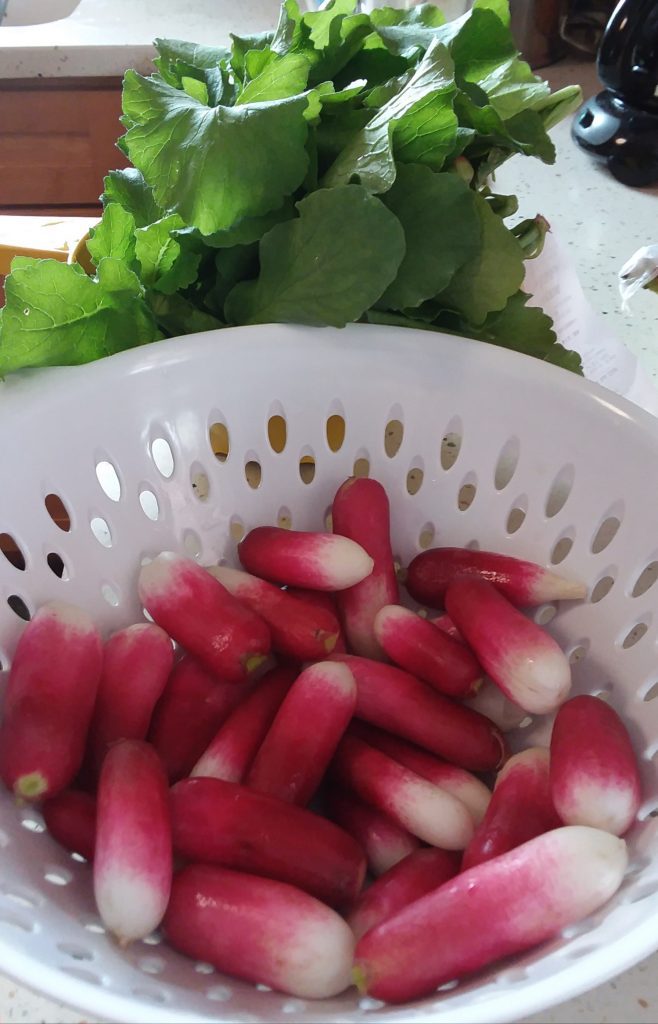

Spring HarvestIn the world of acquiring food, I am happy to be assigned the gatherer designation. Most times this means I head to my favorite grocery stores and explore the many possibilities. Then I return from my gathering and switch to magic mode. All this foodstuff I have purchased must be transformed into deliciousness. So, it’s a two-part role. Until a third duty emerges—preserver.
We have a garden. My husband takes it seriously, plotting and planning the various vegetables which he will attempt to bring forth from the earth to provide the necessary calories to sustain life. Early on, during our newly-arrived-to-Asheville days, we located the seed store which sold the stuff of honest life in the form of heirloom seeds and plants. These are the flora which provide seeds for their own propagation. I bought a book to educate ourselves in the many ways in which to reap and preserve seeds from various foody plants. We understand some of it. We are prepared to actually do some of the things in the book. We are glad we are not dependent on these processes for the sake of our survival. This realization takes a lot of weight off our shoulders and renders gardening into something similar to having a lemonade stand. We might get something from it, but won’t count on it for anything more than treats.
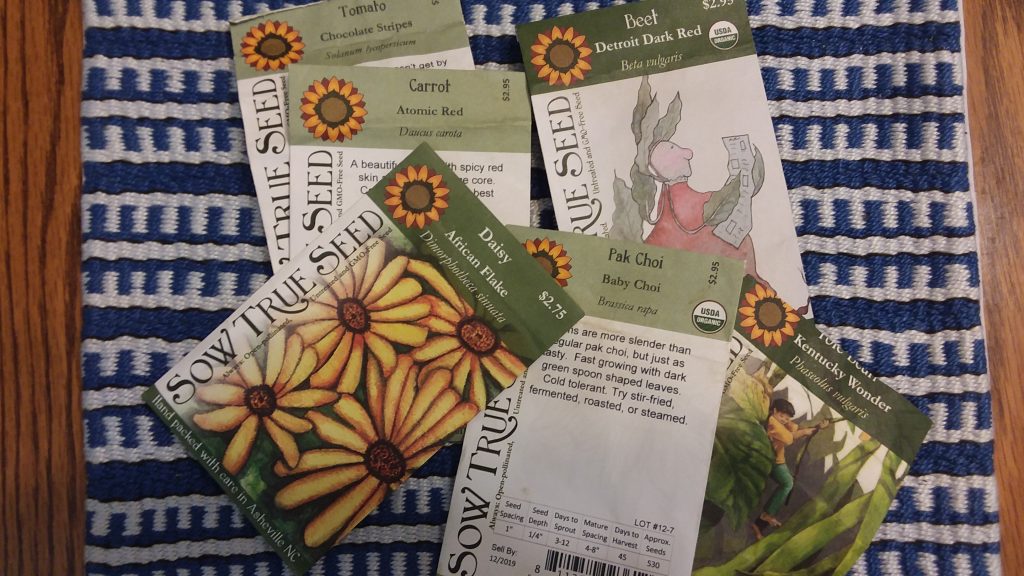

First seeds!After the seeds have been purchased and the grow spots have been designated in the soil of our plots, the timing must be determined. There are numerous adages for when to plant your vegetables and herbs. “Two weeks after the last frost,” is the most annoying one. How would I know when the last frost is? Inevitably, after you plant, another one comes along. “Before your beer has reached its final fermentation,” has some truth to it as you don’t want to be three sheets to the wind when you are doing the serious business of sowing those expensive heirloom seeds. Mountain folk generally say “After Mothers’ Day,” but that would be a Monday and everyone is too busy the first day of the work week. We generally do our planting whenever we feel like it, which makes it so much easier to comply.
The head gardener will tuck a few seeds into cups and stick them under grow lights in the basement. Anyone passing our house might catch a glimpse of what looks like a marijuana-growing operation through our basement windows as we also keep our outdoor plants in the same spot during the winter. It looks like an ambitious undertaking down there. If we have a few warm days, he’ll throw some seeds directly into the raised bed in the back yard and hope for the best. I watch with enthusiasm as things begin to sprout.
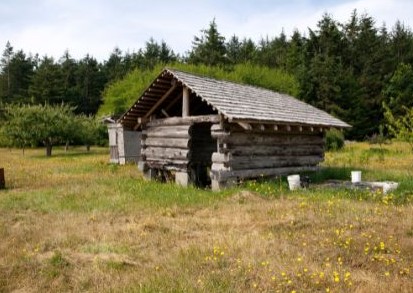

Pioneer homesteadPlanning, planting and watching things grow are so rewarding. The excitement when we pulled the first radish! The bewilderment when we wondered what to do with the next 10. The despair when 50 radishes were scattered over our kitchen countertop and we moaned in disbelief, “Why did we plant so many fucking radishes?” That’s when our preservation skills serve us well. Kinda. Our go-to book, Preserving Summer’s Bounty, recommends root cellaring radishes and other rooty-type veg by any of the following methods. Build a storage room with shelves in a cool (32 to 40 ° F) corner of your basement. Radishes come in spring and then summer follows. We don’t live in Canada. Or, store them in a trash can with a tight-fitting lid. Seems the most appropriate size-wise, but still the temps will be warm down in our cellar until November. Bury your superfluous veg in a box in your yard. This has real potential until you realize you have to dig the thing up every time you want parsnips for your soup. Also noted in this chapter, humidity should be 80 to 95 percent. We keep a dehumidifier going non-stop in the basement because we don’t want 80 to 95 percent humidity in our cellar, root or otherwise. This method of preservation might be handy where the buffalo roam, but not here in the good ol’ south where we fight mold-growing humidity at every turn and the local bears are good at digging stuff up!
Pickling is the next recommendation in our guidebook. Pickling is a method of fermentation in which you cover your chosen vegetable in water and salt and let it sit until happy bacteria form, which prolong the length of time you can safely eat the results. If you have the gumption, you can then use the canning process to stretch out the preservation time. Canning is a terrifying process in which you have to parboil the vegetable of choice in a special way and then boil jars and lids and involves too many safety issues and finding a thermometer in your house that goes up to 240°F. When I’m up to my eyeballs in excess produce, I need a less pioneer method of keeping the goodies edible.
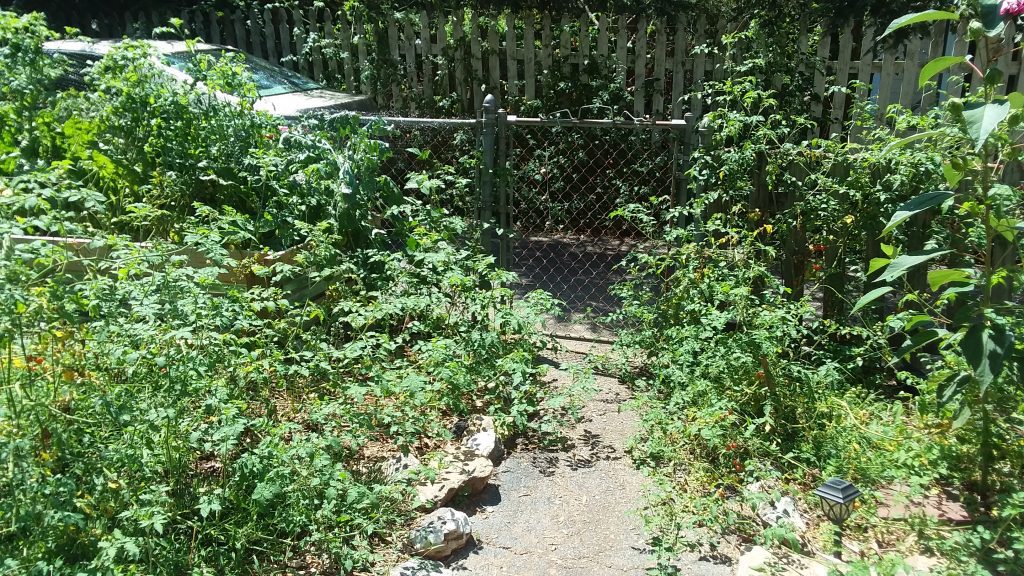

Tomato jungleWe have what we call volunteer tomatoes which grow like weeds and are prolifically fertile. They form a veritable jungle around our little patch of land and provide us with enough unintended crop to last us through the winters. Freezing seemed the only way to go after roasting multiple pans of those little orbs of deliciousness. After the cooking and cooling, I wrap them in waxed paper, shove that into a plastic container and pop it into my upstairs freezer. Next morning, I pull them from the container and stash the resulting hockey puck (our plastic container is round and short) into a gallon baggie marked with the month/year. After that baggie is full, I drop it into our basement freezer. After a couple weeks of daily roasting and freezing, I am ready to chuck our never-ending supply of volunteer tomatoes off a bridge. Mother Nature provides…way too much! Foisting them off on our non-gardening neighbors is the final step.
Next, I plowed through my guidebook to find the chapter on drying your harvest. You can’t dry pickles (wait, maybe you can!), but think fruit leathers, sun-dried tomatoes, any and all vegetable matter you can cut up into small pieces or razor thin slices. I bought a food dehydrator since drying in my sunny yard might attract more nature than I care to accommodate. Which, when I think about it, all that foodstuff is growing out there and being kept safe from the groundhog/squirrel population by one malevolent dog.
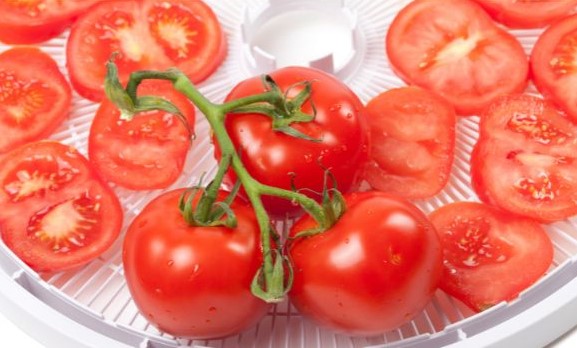

The joy of dehydrating tomatoesI started my drying experimentations with Roma tomatoes—yes, we actually planted more tomatoes. I carefully placed thin slices onto the mesh liners on all six trays of the dehydrator and started it up. The fan inside it made a lot of noise and blew warmish air into my kitchen. I let it go overnight, then gleefully anticipated finding dried tomato slices next morning. I found tomato slices that were suspiciously similar to those I had loaded the day before. Flummoxed by the state of them, I consulted the manual which came with the food dehydrator. The instructions in the manual stated the temperature settings in Celsius, but the dehydrator used Fahrenheit! Why? And how did I not notice this in all the excitement of the day before? After a hasty calculation, I dragged the thing down to my basement, cranked it up to the appropriate temperature setting and allowed it to do the job where I wouldn’t have to hear the noise or feel the heat. I ended up throwing most of them away as they were uneven in actual dried parts vs still moist. But I am now willing to try again after successfully drying some rosemary given to us by our neighbor. Practice, practice, practice.


The happy crewNow, as autumn approaches, we are taking advantage of whatever method of preservation we can use to ensure all the produce is eaten at some time in the near future. We still have hockey pucks of tomatillos from last year’s harvest in our basement freezer. I’ve renewed my research for appropriate recipes. My gardening staff of one gleefully assumes a gatherer role as he hauls the crop inside for immediate use or later consumption. I’m cooking these treats as fast as I can and preserving the goodness to the best of my capacity (tolerance)!
Happily not digging a hole in my yard,
Cheryl




Oh oh oh. That is a lot of work!! I am not a farmer, but you are truly one!! Lots of research you’ve done! I’m happy with what I’ve learned with hanging petunia plants lol and attracting hummingbirds etc.
Congratulations!!
Ps that you for all your comments on my posts. Truly appreciated.
Pps eclipse date is getting closer!!
Attracting hummingbirds here means also attracting bears! But there is a climbing, flowering plant I can see from my work window and hummingbirds are in love with the thing! Sighting one always makes me smile.
Thank you as well for commenting on my blog! That way I know someone is reading it.
The eclipse remark made my heart lurch! When is that again? I don’t think I can handle another road trip until the past one fades into a distant memory!!!!
Eclipse April 8, 2024!! You have time to recover! 😀